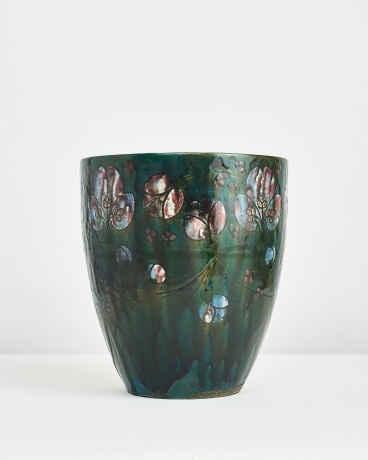

The son and nephew of Beauvais textile manufacturers, Auguste Delaherche had grown up in an artistic millieux. He studied at l'Ecole des Arts Decoratifs from 1877 to 1882 (taking a break 1878-79 for military service) and took courses at stained glass and metalwork studios. In the early years of his career he worked on the restoration of stained glass and became the director of a metal plating workshop for the Paris firm of Christofle. Between 1883 and 1886 Delaherche crafted affordable utilitarian stoneware objects— tobacco jars, goblets and pitchers— and decorated them with thumbprints, fluting, or incised slip at the L'Italienne factory.
In 1887, after years of working in industrial arts firms, Delaherche acquired a Paris studio and began his career as a ceramist. He concentrated on simple forms with thick drip glazes inspired by Japanese pottery, occasionally employing relief decorations or vegetal shapes. In 1894, just seven years after Auguste Delaherche began his career as an art potter, Charles Holme, the editor of The Studio (London), declared him the "master potter of Vaugirard." Having seen an exhibition of Delaherche's vases, jugs, chargers, and bottles at the Champs de Mars in 1889, Holme was particularly taken with their decoration, which consisted entirely of glazes. This, he argued, was evidence that the French had succeeded at last in developing pottery as an art in itself—independent of the painter-decorator (Sept. 1894, vol. 3. no. 18, p. 180). His ongoing experimentation with kiln techniques enabled him to produce remarkably subtle gradations of color and by 1904, he had achieved professional maturity with his robust shapes inspired by Oriental, Greek or rustic pottery, thus helping to usher in the era of modern studio pottery.
In 1887, Delaherche acquired the studio on rue Blomet (in the Vaugirard section of Paris) that Ernest Chaplet had operated for Haviland and embarked at last upon his career as an independent art potter. Often using clay that he brought in from the Beauvais region, Delaherche concentrated on simple forms with thick drip glazes inspired by Japanese pottery. A relief decoration of stylized flowers appeared on some of his vases and he modeled some vases and dishes in vegetal and floral shapes. Delaherche abandoned any technique whose results could not be reproduced and destroyed pots that failed to meet his exacting standards. He later explained: "The art of pottery is a jealous art, demanding absolute fidelity. One must work and seek and find unceasingly, and finding is most difficult of all, because one's discoveries must be made wittingly, with intention." (Gabriel Mourey, The Potter's Art: With Especial Reference to the Work of Auguste Delaherche, The Studio, Nov. 1897, vol. 12, no. 56, p.114). Delaherche took part in the 1887 exhibition at the Union Centrale des Arts Decoratifs and in 1889 he won a gold medal at the Exposition Universelle for the series of stoneware shapes, decorated with quiet, harmonious glazes that Charles Holme had so lavishly praised.
In 1894 Delaherche relocated from Vaugirard to Armentières, a village adjacent to Beauvais, and continued to produce ceramics, gradually moving toward simpler shapes and abandoning relief decoration. Gabriel Mourey reported in his 1897 article, "August Delaherche is a potter and has no ambition to be anything else. He finds it needless to resort to fantastic shapes and ornamentation. His work maintains the strictest simplicity of shape… in which one can always note the impress of the craftsman's hand. He believes that a pot must come direct from the potter's fingers, Accordingly, his curves are simplicity itself, his object being to produce those traditional harmonies of line, the whole charm of which is in their perfect proportions." Mourey further noted that Delaherche "spends the better part of the year among this beautiful Picardy [Beauvais] scenery, working steadily and alone. And every year fresh shapes, fresh patterns, are added to his collection of works which now [in 1897] numbers no less than 800, every one of them quite original and individual, and fashioned by his own hands."
Beginning in 1904, Delaherche threw his own pots (until then his designs had generally been thrown by others). His pieces were unique, generally small and white with aventurine or golden-brown drip glazes. He also made stoneware with glazes in earthy colors. Interested primarily in the relationship between form, color and materials, Delaherche preferred plain, robust shapes inspired by Oriental, Greek or rustic pottery. Simple forms with flowing glazes became the hallmark of his mature style and helped usher in the era of modern studio pottery. From 1910, Delaherche worked in porcelain, favoring translucence and pierced floral motifs. Believing resolutely in the magic of his profession, there is little doubt that he held fast to his 1897 remark until the end of his very successful career: "What a miracle these 1200 degrees of heat can perform! And what joy, what triumph, when one succeeds in bringing to perfection a beautiful piece of pottery, complete and satisfactory in all its smallest details as in its entirety. I can assure you that one's trouble is fully repaid."